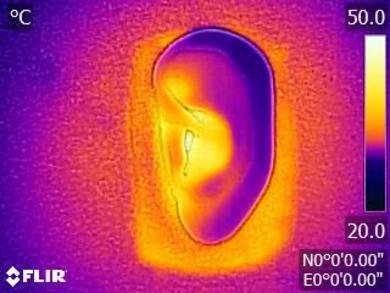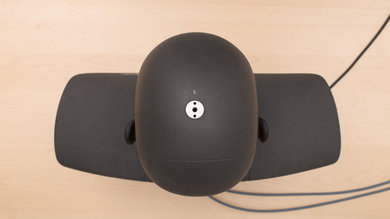The Raycon E25 are okay mixed usage in-ear headphones. They have a comfortable fit that's well-suited for sports with a satisfactory build quality. They're among the lightest and smallest in-ears we've tested so far, but contrary to their size, they have a rather bass-heavy sound that may not please all listeners. Moreover, they lack high-end features like active noise cancelling, and app support for customization. It's worth noting their availability can be somewhat limited, though they can be easily purchased through Raycon's website. All in all, if you're looking for a basic pair of true wireless headphones to take to the gym, they'll perform just fine.
Our Verdict
The Raycon E25 are poor for neutral sound. They have a V-shaped sound signature with a very prominent bass that often overpowers the mids, while the treble can sound sibilant at times. Vocals and lead instruments are noticeably lacking in detail; however, they do have excellent stereo imaging and consistency, provided that you have a proper seal.
- Very consistent listening experience.
- Unbalanced sound profile.
- No app support for customization.
The Raycon E25 are good for traveling and commuting. Although their noise isolation isn't as effective for the low rumbles of bus engines, they perform well when it comes to ambient chatter and high-pitched noises, such as those produced by AC units. Both the earbuds and the charging case are among the smallest and lightest that we've tested, contributing to comfort and portability.
- Small and portable.
- Decent passive noise isolation.
- Unbalanced sound profile.
- High wireless latency.
The Raycon E25 are very good for sports. Because of their size and rounded finish, they're comfortable to wear and provide enough stability that they shouldn't fall out, even when engaged in vigorous exercise. They're rated IPX4 for water and sweat resistance, though this isn't something that we test.
- Small and portable.
- Comfortable, stable fit.
- Unbalanced sound profile.
The Raycon E25 are decent for office use. Since they have good isolation against ambient speech and they hardly leak at all, they should be fine for most offices and shouldn't be annoying to your colleagues, even if you listen at high volumes. The battery probably won't last through an entire workday, but at least they charge very quickly.
- Decent passive noise isolation.
- Leak very little audio.
- Unbalanced sound profile.
- High wireless latency.
The Raycon E25 aren't suitable for wireless gaming. They aren't compatible with the PS4 or the Xbox One consoles, and while you can use them with a PC that has Bluetooth capabilities, there's simply too much latency for the experience to be enjoyable.
The Raycon E25 are Bluetooth-only and can't be used wired.
The Raycon E25 are passable for making phone calls. Your voice is understandable when calling a quiet environment, but the microphone has difficulty separating speech from background noise. Thankfully, these headphones do a decent job of blocking out background noise.
- Decent passive noise isolation.
- Mediocre microphone noise handling performance.
Changelog
- Updated Oct 08, 2021: Converted to Test Bench 1.5.
- Updated Aug 27, 2020: Updated text for accuracy and clarity.
- Updated Feb 05, 2020: Converted to Test Bench 1.4.
- Updated Dec 17, 2019: Review published.
Check Price
Popular Headphones Comparisons
When compared to other true wireless earbuds, especially other models offered by Raycon, the Raycon E25 are a bit of a mixed bag. On the one hand, they're more comfortable and portable due to their size, but on the other, their audio reproduction is heavily unbalanced, which makes them less musically versatile. Nevertheless, they're a good option for those with small ears or even those who like bass-heavy music.
For other alternatives, we suggest taking a look at our recommendations for the best truly wireless earbuds, the best wireless earbuds, and the best noise cancelling earbuds and in-ears.
The Raycon E25 True Wireless are better than the Raycon E55 Truly Wireless in mixed usage. They have a lot in common and both have a very bass-heavy sound, but the E25 are more comfortable, have significantly better noise isolation, as well as a better mic for phone calls. On the upside, the E55 have a much more stable fit, making them a good choice for sports if you tend to have issues with earbuds falling out.
The Raycon E25 True Wireless and the Raycon The Fitness Earbuds (2021 Edition) True Wireless have different strengths, and you may prefer either one. While both headphones are comfortable, the E25 are more so designed for casual, everyday use and have a better noise isolation performance as well as leak less audio. However, the Fitness are sports-oriented headphones with a more stable in-ear fit, a higher IP certification for water resistance, and a better overall battery life.
The Raycon E25 True Wireless are marginally better than the Raycon E50 Truly Wireless in terms of mixed usage. The E25s are more comfortable due to their size, and have much better performance in noise isolation, even boasting a longer battery life and better mic quality, but the E50 have a significantly more accurate audio reproduction, even though they sound dark and also quite bass-heavy.
The Raycon E100 Truly Wireless are better than the Raycon E25 True Wireless for mixed usage. Although the E100 have an overemphasized bass and a sharp treble, they're significantly more accurate in their audio reproduction and have much better noise isolation. Build quality is also much improved over the E25; however, their battery life is quite disappointing, only lasting about 3.5 hours per charge.
Test Results

These fairly small earbuds have a low profile, so they don't stick out from the ear much. Each earbud has a physical button for controls and is branded with the Raycon logo. The glossy finish picks up fingerprints easily. If you're the type to color-coordinate your headphones with your wardrobe, you'll be happy to note they're available in a pretty broad range of eye-catching colors.
These in-ears are small and comfortable to wear, which is good for people with small ears. They do need to be inserted deeply into the ear canal for stability and isolation, which may be uncomfortable for some. Different tip sizes are provided for fit and comfort.
The Raycon E25 have an okay physical control scheme. It's easy to use, and the buttons are clicky, but there are no audio cues when using them except for a voice prompt when turning them on and for pairing.
The Raycon E25 charging case is good. It's small and features a matte black plastic construction that should protect the buds from drops and bumps. There's a micro-USB charging port on the back; unfortunately, it can't be charged wirelessly.
These in-ears have a very bass-heavy, somewhat V-shaped sound profile that yields a fairly crisp listening experience. There's a large dip in the mid-range and lower treble that makes vocals and leads sound farther away. Their treble is bright, which makes S and T sounds piercing and occasionally painful.
The Raycon E25's frequency response is excellent. Once you achieve a proper seal, tracks should sound virtually identical every time you wear them.
These earbuds' bass accuracy is terrible. Although they have good bass extension, they're overemphasized throughout the entire range, particularly in the high-bass, making them sound muddy and boomy.
These headphones have poor mid accuracy. The overemphasis in the low-mid makes them sound muddy, while the drop in the mid-mid causes vocals and lead instruments to be veiled and nudged farther back in the mix, often being overpowered by the bass.
The Raycon E25's treble accuracy is sub-par. Low treble is a tad bit uneven, but vocals and lead instruments should sound mostly detailed and present. Unfortunately, the peak around the mid-treble range causes some sibilants to sound overly sharp and piercing.
These headphones deliver an inadequate peaks and dips performance. The mid-range is almost lost in the overwhelming bass response, while the peak in the treble makes higher notes sound sharp and piercing.
The Raycon E25 have excellent stereo imaging performance. The weighted group delay is well below the audibility threshold, keeping the bass tight and the treble transparent. The L/R drivers are also well-matched in amplitude, frequency, and phase response, which is important in accurately placing the location of objects and sound effects in the stereo image. This, in turn, results in a more immersive listening experience. That said, these results are only valid for our test unit, and yours may perform differently.
Like most in-ears, the Raycon E25 have an awful passive soundstage. They don't interact with the outer ear by design, which is essential for creating a spacious, out-of-head experience.
These headphones don't have any virtual soundstage features.
The Raycon E25's weighted harmonic distortion performance is decent. Reproduced frequencies stay within acceptable limits, for the most part, making their audio reproduction fairly clean and pure.
These are the settings used to test the Raycon E25. Our results are only valid when they're configured this way.
With a proper fit, these in-ears have satisfactory noise isolation. They perform rather poorly when it comes to the bass range, where the rumbles of bus and airplane engines sit. However, they shine in the mid and treble range, as they block out quite a bit of ambient chatter and higher-pitched background noise, like the hum of a nearby AC unit.
These earbuds have outstanding audio leakage performance. They hardly leak at all, so you shouldn't bother those around you even if you listen to your music at a high volume.
These headphones have an integrated mic.
The microphone's recording quality is passable. Speech is natural and almost completely free of distortion, but also quite thin and muffled, so people on the other end of the line may occasionally have a hard time understanding you.
The microphone's noise handling capability is mediocre. It has trouble separating your voice from background noise, and when used in a very noisy environment like a subway, your voice is overpowered and incomprehensible to people on the other end of the line.
The Raycon E25's battery performance is passable. It comes close to the advertised six hours of continuous playback and will enter a standby mode when no activity is detected. They also turn off after a few minutes if they're not connected to any device, and they take less than an hour to charge. Their case yields an additional three full charges, which should be more than enough to get you through the daily 9 to 5. If you're looking for Raycon earbuds that have a better battery performance, try the Raycon The Fitness Earbuds (2021 Edition) True Wireless instead.
There's no dedicated mobile companion app for these earbuds.
The Raycon E25's Bluetooth performance is alright. They support Bluetooth 5.0, but not multi-device or NFC pairing. Their latency across all platforms is too high to recommend them for watching videos or for gaming, though apps and devices seem to compensate for this lag differently, so your results may vary with real-world usage.
These headphones are Bluetooth-only.















